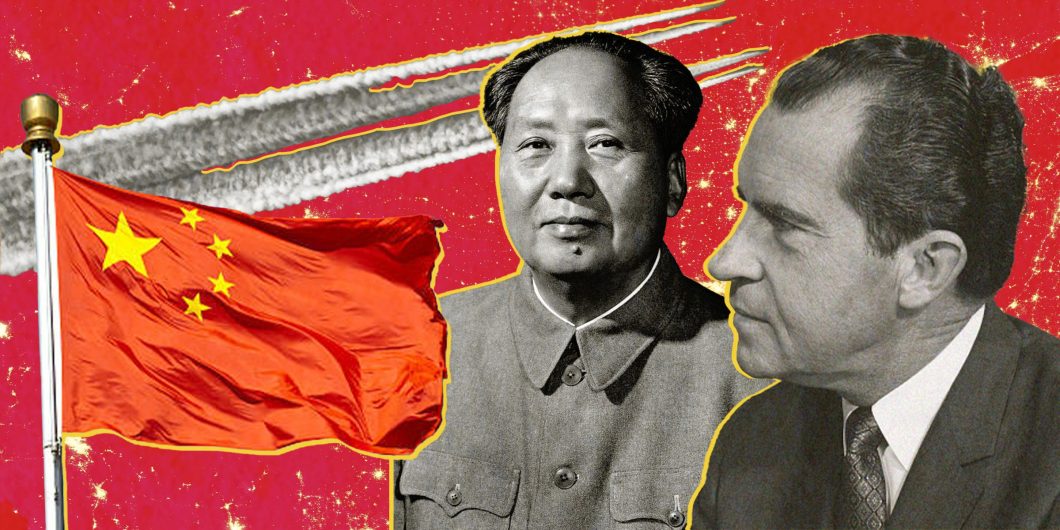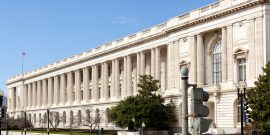Nixon’s New Red Century
“Taking the long view, we simply cannot afford to leave China forever outside the family of nations…there is no place on this small planet for a billion of its most potentially able people to live in angry isolation.” Richard Nixon penned one of his most consequential statements for Foreign Affairs, but the reason for its significance is very different today than it was in 1967.
Amid the Cold War, the announcement that Nixon, one of the most devout anti-communists in American politics, would be making a landmark visit to Beijing was met with surprise and awe. The Washington Post at the time explained, “If Mr. Nixon had revealed he was going to the moon, he could not have flabbergasted his world audience more.”
The political reaction was mixed. Nixon’s determination to “open the world” set the tone for the right. His intentions were simple: bring China onto the world stage with hopes that they will eventually become a friend rather than a foe—a prosperous, democratic business partner rather than a bitter, isolated communist rival.
And so, in 1972, President Nixon landed on the tarmac in Beijing. In his memoir, the President recalled, “When [Chinese Premier Chou En-lai and my] hands met, one era ended and another began.” He was right. Nixon believed that America and China had common interests that could overcome differences. As a result, the Shanghai Communiqué was signed as a treaty between the two nations. It was a landmark step toward bringing China out of darkness, but what China would do in the light was unknown.
For the remainder of the 20th century and far into the 21st century, Democratic and Republican presidential administrations saw bilateral relations with China as a benefit rather than a detriment. As George W. Bush said of China, “One of my dreams for our world is that these two powerful giants will continue working toward a full partnership and friendship that will bring peace and prosperity to people everywhere.”
While this warming relationship was a slow burn through the 1970s, it picked up speed with Jimmy Carter granting full diplomatic recognition of China and affirming the One-China policy, dealing a blow to Taiwanese sovereignty. This landmark legislation strengthened diplomatic relations with China and normalized the CCP across federal government entities.
Slow steps toward normalizing relations continued. But in 2000, with President Clinton signing the U.S.-China Relations Act of 2000, the manufacturing floodgates opened, and the considerably poor nation was handed economic opportunities never seen before. The transformation was complete.
This diplomatic transformation led to global trade of monumental proportions for China. Trade between the United States and China rose from $5 billion to $231 billion between 1980 and 2004. Shortly thereafter, China became our second largest trading, overtaking Canada.
This bustling trade activity was driven mostly by the Chinese manufacturing economy. Very quickly, the United States and the rest of the Western world grew accustomed to the lower prices of Chinese goods. This trend is evident as China accounts for nearly one-third of all manufacturing output in the world.
The cost of China’s bustling manufacturing economy was our own manufacturing economy. While China’s manufacturing economy boomed, ours busted. From 1989 to 2019, U.S. manufacturing jobs plummeted by nearly 50%.
We are all familiar with the growth path of China’s economy—but perhaps more critical is how China has used this growth to gain and wield its influence worldwide.
China’s transformative action has reached beyond its borders. With more resources and a cooperative people, the CCP has been able to focus on building global influence and military might. China has been strengthening relations with countries in key regions of the world and providing resources to poor countries in exchange for loyalty and special economic favors. This program is part of the Belt and Road Initiative (BRI). While this initiative hasn’t been the power grab China was hoping for, it has still seen some key successes in advancing China’s imperial quest for influence and military might.
China has lent trillions of dollars to poor but strategically valuable countries for infrastructure projects and economic development. Once indebted to the CCP, these countries are forced to do favors for China until the debt is paid, which it seldom is. In Sri Lanka, for example, financial turmoil has long plagued the country—and while China forgave $8 billion in loans, they demanded a 99-year lease of the Sri Lankan port. With access to ports like these, China can control trade beyond its borders and expand its military operations. More eye-opening is the hold China has on Africa. Chinese lending accounts for 20% of the African continent’s debt.
Poor countries aren’t the only target. China has followed a different manipulation strategy in wealthy, westernized nations across Europe and North America. By stealing the intellectual property of American and European companies, the CCP has built state-sponsored tech giants like Huawei and started to build infrastructure such as 5G in wealthy countries. And to support their militaristic ambitions, they have begun buying up land in wealthy countries, much of which is strategically located near military bases.
While our leaders over the last several decades smiled and shook hands with Chinese officials, the CCP built an empire of oppression, military might, and fear, standing in complete opposition to our values.
Today, the CCP is more emboldened than ever. Now that they have swallowed up Africa, South America, and Europe as the top trading partner, expanded their military capabilities, and modernized, they are a freight train looking to unseat the United States as the top superpower. But the freight train has some obstacles in its way.
China is faced with unique challenges today. Its rapid economic growth is being disrupted by a shift away from the liberal market policies that carried them into the 21st century. Following the 2008 Financial Crisis, China began walking back many of these economic freedoms in exchange for a tighter state-controlled economy. Though economic growth continued to boom, it certainly slowed and now, post-COVID, there is data supporting the fact that the Chinese economy is beginning to shrink.
Mounted on top of this is another crisis: property and housing. Over the last 10 years, loans to the property sector have gradually ballooned, and now, with a slow economy and unique supply challenges post-pandemic, real estate projects are being severely delayed and home buyers are less confident than ever in the housing sector. These mounting challenges create a growing crisis for the country’s $56 trillion dollar banking system.
These unique challenges at home have created a stir within the CCP and present grave dangers to the rest of the world. President Xi Jinping is doubling down on his control over the party. He has begun to remove market-focused reformers like Premier Li Keqiang from the government, suggesting further state control over the massive Chinese economy. The risk posed to the rest of the world is simple: If Xi is willing to make rash decisions at home to secure his power, what will he do to the rest of the world if threatened?
The Chinese people, disheartened by the economic slowdown and mortgage crisis, still seem indifferent to shifting back to markets. With more manufacturing came more high-paying jobs for Chinese nationals. With more high-paying jobs came rapid urbanization. With rapid urbanization came an expansion of the service industry and luxury goods sales. Chinese people have an increasing taste of Western decadence. And yet, aside from regions like Hong Kong, there has been little to no desire for Westernization or democracy. Why?
American elites have long theorized that once the Chinese people got a taste of westernization and a higher quality of life, they would begin to demand certain things of their government—among them, more rights and democracy. But that hasn’t happened and never will. Western optimism ignored thousands of years of Eastern and Confucian tradition still deeply embedded in the Chinese people. As a result, they have no experience with self-governance and no desire for it.
The Eastern way of thinking about government is simple: The government is a source of benevolence and meant to foster a harmonious society. To the Chinese people, the individual hardly matters. What is good for society is good for the individual. Utilitarianism and efficiency are more important than individuality and the gridlock associated with democracy.
The Chinese people will remain cooperative as long as their government is seen as addressing the needs of society and the nation. What happens outside of the boundaries of China hardly matters in this framework.
While our leaders over the last several decades smiled and shook hands with Chinese officials, the CCP built an empire of oppression, military might, and fear, standing in complete opposition to our values. The actual Red Century has turned out to be the 21st century. Communist countries of the 20th century reached economic and political heights on the world stage—but these heights were built on shifting sands. Today, China is one of the most powerful nations in the world.
Though China’s foundation is developing severe cracks, namely economic slowdown, housing challenges, and a potential banking crisis, they are better positioned economically, diplomatically, and militarily than any other communist country in history—and in the face of threats to the regime, the CCP is an even greater danger to the rest of the world than it was in times of prosperity.
Nixon and Mao both were taking “the long view” with the Shanghai Communiqué—but it has become abundantly clear that these views were fundamentally different and couldn’t be reconciled. While we may be acting on this impending crisis now, perhaps it is too late.



